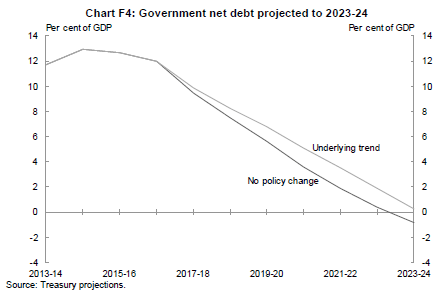
Economic and financial forecasting is tough at the best of times, let alone for an $1.4 trillion economy that is subject to a myriad of competing influences that can change track at the blink of an eye. For this reason, I don’t envy the Australian Treasury when it attempts to forecast the future direction of the Federal Budget – a near impossible process that is bound to lead to error and a spate of criticism from commentators.
That said, I don’t agree with the Treasury’s medium-term projections outlined in yesterday’s Pre-Election Economic and Fiscal Outlook (PEFO), which forecasts a strong return to surplus and the complete elimination of public debt within ten years.
According to the Treasury, based on a “no policy change basis” with real growth in payments limited to 2% a year on average, the underlying cash surplus is projected to grow after the forward estimates to reach 1% of GDP in 2020-21 (see next chart).

Similarly, net public debt is projected to return to zero in 2023-24 (see next chart).

The reasons why I don’t perceive Treasury’s medium-term projections as being realistic were explained in detail in The three three horsemen of a Budget Apocalypse, which articulated three medium to longer-term structural headwinds that will likely lock Australia’s governments into deficits for many years to come under current taxation arrangements.
The first of these headwinds are the falling terms-of-trade, brought about by declining commodity prices, which will weigh on national income growth and depress collections of company taxes, personal taxes, GST, as well as state mining royalties.
The second related headwind is the decline of mining-related capital expenditures, which will detract from Australia’s GDP growth and employment over a number of years, again placing pressure on government budgets via lower personal and company tax receipts and GST, as well higher welfare payments.
The final and most important (but longer-term) structural headwind relates to Australia’s ageing population, which will see Australia’s dependency ratio rise significantly and the proportion of workers to non-workers (as well as the employment-to-population ratio) fall, making it much more difficult for the Government to raise the required amount of tax revenue at the same time as it faces rising health and aged-care costs.
In short, without undertaking radical reforms to the way taxes are collected (e.g. more reliance on consumption and land taxes), in addition to greater expenditure restraint, it will be next to impossible for the Government to achieve a budget surplus and eliminate net debt within a decade.

